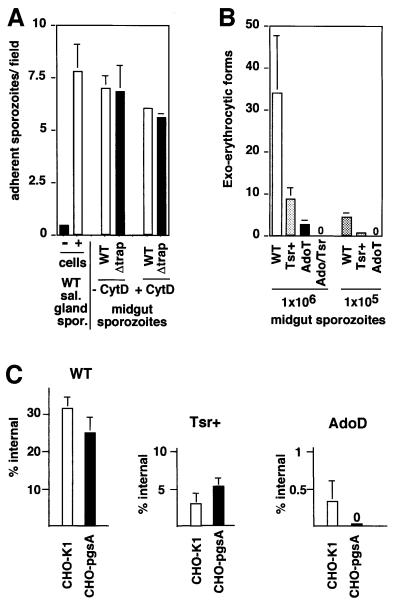Fig. 5. The TRAP ectodomain is important for sporozoite invasion of, but not adhesion to, cultured cells. (A) TRAP is dispensable for sporozoite adhesion to HepG2 cells. Midgut sporozoites (50 000) were pre-incubated for 15 min in the presence or absence of 2 µM Cytochalasin D subsequently incubated for 90 min with confluent HepG2 cells, and sporozoites that remained bound to cells after washings were stained with anti-CS antibody. Adhesion is shown as the mean number of bound sporozoites in one microscopic field (400× magnification), from two sets of experiments done in quadruplicate each. (B) The TRAP A-domain and TSR are required for invasion of HepG2 cells. Midgut sporozoites (1 000 000) were added to subconfluent HepG2 cells (multiplicity of infection = 1), and EEF that develop inside cells were immunostained 48 h later. The mean numbers of EEFs from two experiments carried out at least in triplicate each are shown. (C) Cell invasion into WT CHO cells (CHO-K1) and GAG-deficient CHO cells (pgsA). Salivary gland sporozoites were incubated for 90 min with confluent CHO cells (empty bars) or pgsA derivatives (black bars) at a multiplicity of infection of 0.01, and the proportion of internalized sporozoites was assessed by differential immunostaining of extra and intracellular sporozoites (10 000 cells examined for each population). Left, GAG chains are of minor importance for WT sporozoite invasion into CHO cells. Center, TSR+ salivary gland sporozoites enter GAG-deficient cells with similar efficiency to WT cells. Right, AdoD sporozoites invade cultured cells in a GAG-dependent fashion.

An official website of the United States government
Here's how you know
Official websites use .gov
A
.gov website belongs to an official
government organization in the United States.
Secure .gov websites use HTTPS
A lock (
) or https:// means you've safely
connected to the .gov website. Share sensitive
information only on official, secure websites.
